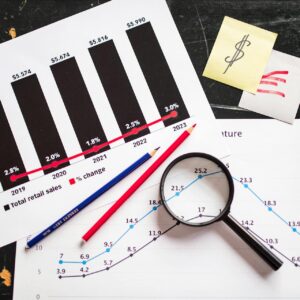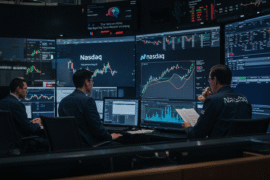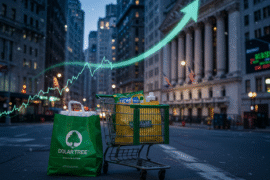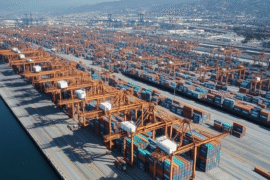This article may contain references to products or services from one or more of our advertisers or partners. We may receive compensation when you click on links to those products or services. Nonetheless, our opinions are our own.
As summer draws close and the world grapples with the ever-evolving energy landscape, you may have noticed the growing dialogue around liquefied natural gas (LNG) and its pivotal role in shaping markets and geopolitical dynamics. Recently, Shell announced that 9 out of 10 U.S. LNG shipments are destined for Europe, highlighting the urgency of the situation. With the continent striving to reduce reliance on traditional energy sources, this surge in American LNG exports underscores both immense potential and significant challenges. However, despite these shipments, the stark reality remains: it is still insufficient to balance the market. We will delve into the intricacies of Shell’s strategy, the implications for Europe’s energy security, and why the current levels of LNG supply are proving insufficient in the broader context of global energy demands.
- Understanding the Current Landscape of U.S. LNG Shipments to Europe
- The Impact of European Energy Needs on Global LNG Supply
- Evaluating the Challenges of Balancing the LNG Market
- Practical Insights on How Shell and Others Can Strengthen Supply Chains
- Exploring Future Opportunities for LNG Export Growth
- Recommendations for Investors in the LNG Sector
- Recommended Reads
Understanding the Current Landscape of U.S. LNG Shipments to Europe
A significant shift in U.S. liquefied natural gas (LNG) shipments toward Europe has occurred. Recent research highlights that approximately 90% of U.S. LNG exports are now heading to European destinations, driven primarily by the region’s pressing need for energy security amid geopolitical tensions. This shift reflects a broader strategy among European nations to reduce their dependence on Russian gas supplies, leading to a surge in demand for alternative sources.
However, despite this dramatic shipment increase, experts warn that it may not be sufficient to bring long-term stability to the market. Consider the following factors:
- Seasonal demand fluctuations: Winter months frequently see curtailed supply or unexpected spikes in consumption.
- Infrastructure constraints: Both the U.S. and Europe face limitations in terminal capacities and regasification capabilities.
- Global competition: Countries like China and Japan are also vying for LNG, leading to bidding wars that increase prices.
To put it in perspective, here is a table illustrating recent trends in U.S. LNG exports:
| Month | Volume (Bcf) | Percentage to Europe |
|---|---|---|
| January | 200 | 85% |
| February | 150 | 90% |
| March | 180 | 90% |
While the current landscape shows a robust flow of LNG to Europe, the challenge remains: how can the market adapt and prepare for continued volatility? Understanding these dynamics will help stakeholders make informed decisions moving forward.
The Impact of European Energy Needs on Global LNG Supply
With the recent shifts in energy demand, particularly from European markets, the transportation logistics and market dynamics surrounding global LNG supply have substantially changed. As noted earlier, 9 out of every 10 U.S. LNG shipments are now directed toward Europe. This surge is primarily motivated by Europe’s urgent need to wean itself off Russian gas supplies. However, the high demand continues to outpace the supply, causing ripples throughout the entire market and impacting prices and availability worldwide.
To illustrate the imbalance, consider these factors affecting the LNG supply chain:
- Infrastructure limitations: Significant investment is required to expand LNG terminals.
- Logistical challenges: Increased shipments create bottlenecks at ports, leading to delays.
- Market volatility: Prices fluctuate because of geopolitical uncertainties affecting long-term contracts.
The data below reflects the current distribution of U.S. LNG shipments:
| Destination | Percentage of Total Shipments |
| Europe | 90% |
| Asia | 7% |
| Other | 3% |
While European demand drives most shipments, these shortfalls highlight the need for diversified energy sources and solutions. Businesses, households, and governments must stay ahead of these trends to ensure energy reliability in the future.
Evaluating the Challenges of Balancing the LNG Market
The global LNG market is more complex than it might seem initially. Despite the significant number of U.S. shipments to Europe, the challenge of effectively balancing the market persists. Several factors contribute to this shortfall:
- Geopolitical tensions: Ongoing conflicts and political instability create fluctuations in both supply and demand dynamics.
- Infrastructure limitations: Not all receiving terminals in Europe can handle significant LNG surges, limiting effective distribution.
- Seasonal demand variability: Demand frequently skyrockets during winter months, putting additional strain on an already tight market.
Staying informed about these challenges is crucial for understanding market trends. Monitoring geopolitical developments, infrastructure limitations, and seasonal demand shifts can offer a more comprehensive understanding of the market’s health. While the situation may feel overwhelming, knowledge empowers stakeholders to make informed decisions in trading, investment, or broader economic planning.
Practical Insights on How Shell and Others Can Strengthen Supply Chains
Companies like Shell must embrace a multifaceted approach that hinges on collaboration, technological investment, and transparency to bolster supply chains effectively. Here are a few practical steps to consider:
- Enhance collaboration: Build stronger partnerships with suppliers and logistics providers to share essential data and insights, improving demand forecasting and supply management.
- Invest in technology: Leverage advanced analytics and artificial intelligence to optimize inventory management. Predictive tools can help adjust strategies proactively.
- Prioritize transparency: Maintain open lines of communication across the supply chain to foster trust and allow quicker responses to emerging challenges.
Considering the current landscape of energy markets, adopting flexible sourcing strategies may also be beneficial. The following table illustrates potential alternative sourcing regions for LNG shipments:
| Region | Potential Advantages |
| North America | Shorter shipping times, lower transport costs |
| Middle East | Stable supply, large reserves |
| Southeast Asia | Diverse market options, emerging suppliers |
Adopting these strategies could substantially enhance operational effectiveness, ensuring that despite external pressures, supply chains remain resilient and responsive.
Exploring Future Opportunities for LNG Export Growth
As the landscape of LNG exports evolves, it is essential to recognize the shifting dynamics influenced by geopolitical tensions and market demands. Despite 90% of U.S. LNG shipments heading to Europe, current export levels still fall short of balancing the market. This opens up various opportunities for LNG export growth:
- Investing in infrastructure: Upgrading export terminals and pipelines can significantly enhance capacities and efficiency.
- Diversifying markets: Beyond Europe, emerging markets in Asia and Africa present new revenue streams.
- Strategic partnerships: Collaborating with international companies can foster growth through shared technology and resources.
- Leveraging renewable LNG: As sustainability becomes a priority, green LNG projects could attract environmentally conscious investors.
Recommendations for Investors in the LNG Sector
To navigate the evolving LNG sector, consider these investment strategies:
- Understand market dynamics: Stay updated on European energy policies and market demands.
- Diversify your portfolio: Consider renewables or conventional energy investments to mitigate risks.
- Monitor production and shipping costs: Pay attention to trends in production and transportation expenses, which directly impact profit margins.
Investors can capitalize on potential growth while mitigating inherent risks in the LNG market by closely monitoring these factors.

Reviewed and edited by Albert Fang.
See a typo or want to suggest an edit/revision to the content? Use the contact us form to provide feedback.
At FangWallet, we value editorial integrity and open collaboration in curating quality content for readers to enjoy. Much appreciated for the assist.
Did you like our article and find it insightful? We encourage sharing the article link with family and friends to benefit as well - better yet, sharing on social media. Thank you for the support! 🍉
Article Title: Shell Sends 90% of U.S. LNG to Europe—Is It Enough?
https://fangwallet.com/2025/02/13/shell-sends-90-lng-to-europe/The FangWallet Promise
FangWallet is an editorially independent resource - founded on breaking down challenging financial concepts for anyone to understand since 2014. While we adhere to editorial integrity, note that this post may contain references to products from our partners.
The FangWallet promise is always to have your best interest in mind and be transparent and honest about the financial picture.
Become an Insider

Subscribe to get a free daily budget planner printable to help get your money on track!
Make passive money the right way. No spam.
Editorial Disclaimer: The editorial content on this page is not provided by any of the companies mentioned. The opinions expressed here are the author's alone.
The content of this website is for informational purposes only and does not represent investment advice, or an offer or solicitation to buy or sell any security, investment, or product. Investors are encouraged to do their own due diligence, and, if necessary, consult professional advising before making any investment decisions. Investing involves a high degree of risk, and financial losses may occur including the potential loss of principal.
Source Citation References:
+ Inspo












































